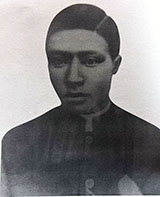Otu, Samuel

Samuel Otu was a Ghanaian teacher-catechist of the Basel Mission in the Gold Coast (1870-1900).
Otu was born in Larteh-Akuapem in November 1870. He was born to Theodore Yaw Tweedi and Nana Ama Owiredua. He was baptized by Rev. David Asante in December, 1870. In 1896, he married Sarah Afua Yaago, and the couple had two children, Otubea and Yaw Tweedi. The marriage was blessed by Rev. Esau Ofori at Larteh.
In that same year, the Basel Mission in what was then called the Gold Coast (present-day Ghana) planted their first church in Asante. As a result of this, many churches were established in rapid succession. It became necessary to send more African workers to Asante. Since the native Asante workers were few in number, trained catechists from Akuapem, Akyem, and Kwahu were the first to work on Asante territories.
Trained in Akropong Seminary, Otu started his work as a teacher-catechist in Abiriw-Akuapem. He also held pastorates at Tutu, Akwamufie, Anum Apapam, Begoro, Ejisu, Asante Agona and Takyimantia. These were mainly preaching treks. He also took charge of small congregations.
He was transferred to Takyimantia in 1899, after working for a while in Asante Agona. This particular transfer was made upon a request from the chief of Duayaw Nkawanta, Kwame Boakye, who wanted a school to be started in his community. At this request, Rev. Fritz Ramseyer sent Otu and his family to Takyimantia.
He was not well received by the people in Takyimantia. He persevered to start a mission among the people of Takyimantia without focusing on their excuses. It was around this time that there was tension between the British and Asantes over the golden stool. This led to a war which is commonly known as the Yaa Asantewaa war. The Asantes considered any person allied with Europeans to be a spy or traitor. The Asantes revolted against the British forces, and the people associated with the Basel Mission were persecuted.
Most of the mission workers (Europeans and Africans) escaped with their lives. Even though Otu was notified of the war between the Asantes and the British, he intentionally decided not to escape. He believed that this was the place God has sent him to start a church and a school. The people in Kumase, the Asante capital, were refugees in the Kumase Military Fort Museum for about three months.
News arrived in Kumase that there was an African spy who was taking notes and reporting them to the Europeans. This false accusation later became his charge for arrest. He was arrested on April, 5, 1900 by a delegation from Kumasi. He was tortured and beheaded on a street on April, 10, 1900 [1]. He was likely buried without his head.
After the execution, it is said that Osei Hwim the executioner could not stay at one place but moved around from place to place. Neither the Basel Mission nor Otu’s loved ones sought to retaliate but he feared that he would be killed by someone. One of the (other) people involved in Otu’s death was Akwasi Mmora. Out of guilt, Akwasi joined the Christian community and became a catechumen by 1911. He became a great witness of the faith he once persecuted. It should be noted that within three years, all those who were associated with the death of Otu had miserable ends.
Otu’s wife Sarah Afua Yaago was rescued by the British government nine months later, and she returned to Larteh after nine months. She died in 1962, aged 88. Her funeral was attended by delegates from Takyimantia.
A chapel was dedicated in 1931 to Otu’s memory at Takyimantia by Rev. Karl Hartenstein, then superintendent of the Basel Mission. This chapel was dedicated at the very spot Otu was executed. In 2020, this chapel was refurbished and rededicated by Rev. Dr. William Ofosu Addo, presbytery chairman of the Brong Ahafo Presbytery of the Presbyterian Church of Ghana.
On April, 10, 2000, a centenary anniversary was held at Takyimantia in Otu’s memory. Samuel Otu Memorial Congregation in his hometown in Larteh-Akuapem has been named after him. Also, the Senior High School and the congregation in Takyimantia have been named after him. There is a museum in his memory at Takyimantia.
Some scholars such as H. W. Debrunner and Emmanuel Braffi have been opposed to accepting his death as that of a religious martyr because they interpret it as the result of a political conflict between the British and the Asantes. Nevertheless, Samuel Otu is still celebrated as the first Christian martyr in Ghana. Even non-Presbyterians celebrate his legacy.
Emmanuel Anim Nyanteh
Notes
- It is also possible that he was killed on April, 17, 1900. See F. A. Ramseyer, Dark and Stormy Days in Kumassi. London: J. W. Partridge, 1901, 230.
Bibliography:
Agyemang, Fred. Ghana’s First Christian Martyr: Samuel Otu 1870-1900. Accra: Waterville Publishing, 1987.
——–Our Presbyterian Heritage. Accra: Presbyterian Press, 2005.
Amankonah, Kwaa Edmund. The Story of Samuel Otu: A Christian Martyr of the 19th Century. Osu: Heritage Publications, 2017.
Ansah, J. K. Centenary History of Larteh Presbyterian Church. Accra: The West African Graphic, 1956.
Braffi, Emmanuel K. Samuel Otu - Reincarnation and the Law of Karma. Kumasi: Emmanuel Press, 1987.
Debrunner, Hans. History of Christianity in Ghana. Accra: Waterville Publishing House, 1967.
Keteku-Afari, H. J. Asante Presbiteri Asempatrew Adwuma Ho Asem. No publisher, 1926.
Koramoa E. T. and Reynolds, Edward. Ghana Presbyteri Asafo: Mfe Ɔha ne Aduonum Adwuma 1828-1978. Accra: Waterville Publishing House, 1978.
Kwamena-Poh, M. A. The Reverend Ramseyer and the Foundation of the Presbyterian Church in Kumasi. Kumasi: University Press, 1973.
Nkansa-Kyeremanteng, Kofi. The Presbyterian Church of Ghana: History and Impact. Santasi: Sebewie De Ventures, 2015.
Ofei, Amoako. Samuel Otu (1870-1900): Ghana Kristofo Mogya-Danseni a Odi Kan. Accra: Presbyterian Press, 1991.
Ringwald, Walter. Stafette in Afrika. Stuttgart: Evangelische Missionsverlag, 1957.
Ramseyer, F. A. Dark and Stormy Days in Kumassi. London: J. W. Partridge, 1901.
Schlatter, Wilhelm. Geschichte der Basler Mission, Vol. 3. Basel: Verlag der MissionBuchhandlung, 1916.
Smith, Noel. Presbyterian Church of Ghana,1835-1960: A Younger Church in a Changing Society. Accra: Ghana Universities Press, 1966.
Steiner, P. In Fiendesland, Erlebnisse Eingeborner Missionsgehilfen Während des AsanteAsuftandes. Basel: Verlag der Missionbuchhandlung, 1901.
Primary sources: Narration of the event told by his wife, Sarah Yaago to Rev. N. T. Clerk was issued in Kristofo Sɛnkafo, 1911, pp., 6-8, 16-18 and 60. A translation is provided by Fred Agyemang and Edmund Amankonah. For a note on the aftermath of the executioner and those who arrested him, see pp. 64-66 of the 1911 Kristofo Sɛnkafo. A museum in memory of Otu is located at Takyimantia.
This article, submitted in November, 2024, was researched and submitted by Emmanuel Anim Nyanteh, a graduate of Trinity Theological Seminary, Legon, and a member of the Presbyterian Church of Ghana, Christ Congregation Afutu-Nsawam.



